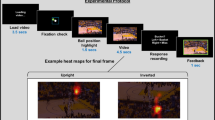Abstract
How does the nervous system synchronize movements to catch a falling ball? According to one theory, only sensory information is used to estimate time-to-contact (TTC) with an approaching object1,2; alternatively, implicit knowledge about physics may come into play3,4. Here we show that astronauts initiated catching movements earlier in 0 g than in 1 g, which demonstrates that the brain uses an internal model of gravity to supplement sensory information when estimating TTC.



Similar content being viewed by others
References
Gibson, J. J. The Senses Considered as Perceptual Systems (Houghton Mifflin, Boston, 1966).
Lee, D. N. in Tutorials in Motor Behavior (eds. Stelmach, G. E. & Requin, J.) 281–296 (Elsevier, Amsterdam, 1980).
Lacquaniti, F., Carrozzo, M. & Borghese, N. A. in Multisensory Control of Movement (ed. Berthoz, A.) 379–393 (Oxford Univ. Press, Oxford, 1993).
Hubbard, T. L. Psychon. Bull. Rev. 2, 322–338 (1995).
Lee, D. N., Young, D. S., Reddish, P. E., Lough, S. & Clayton, T. M. Q. J. Exp. Psychol. A 35, 333–346 (1983).
Savelsbergh, G. J., Whiting, H. T., Burden, A. M. & Bartlett, R. M. Exp. Brain Res. 89, 223–228 (1992).
Rushton, S. K. & Wann, J. P. Nat. Neurosci. 2, 186–190 (1999).
Peper, L., Bootsma, R. J., Mestre, D. R. & Bakker, F. C. J. Exp. Psychol. Hum. Percept. Perform. 20, 591–612 (1994).
Lee, D. N., Craig, C. M. & Grealy, M. A. Proc. R. Soc. Lond. B Biol. Sci. 266, 2029–2035 (1999).
Tresilian, J. R. Trends Cogn. Sci. 3, 301–310 (1999).
Werkhoven, P., Snippe, H. P. & Toet, A. Vision Res. 32, 2313–2329 (1992).
Lacquaniti, F. & Maioli, C. J. Neurosci. 9, 134–148 (1989).
Collewijn, H. Brain Res. 36, 59–70 (1972).
Lackner, J. R. & DiZio, P. Exp. Brain Res. 130, 2–26 (2000).
Regan, D. J. Sports Sci. 15, 533–558 (1997).
Acknowledgements
Support was provided by the French space agency CNES, the Italian space agency ASI and the Italian Ministry of Health. We thank the NASA Flight Research Management Branch, the Lockheed Martin Space Operations Company, the Kinélite development team, the STS-90 astronauts (S. Altman, J. Buckey, A. Dunlap, K. Hire, R. Linnehan, C. Mukai, J. Pawelczyk, R. Searfoss, D. Williams) and M. Venet, A. Lee, D. McMahon, B. Marchiel, M. Pias, and F. Silvagnoli for development of the flight experiment; D. Angelini, M. Ehrette, P. Leboucher, P. Prévost and M. Zaoui for technical assistance; L. Amadio, M. Buderer, A. Guëll, O. Marsal and S. McCollum for program support; and D. Alais, M. Amorim, M. Carrozzo, J. Droulez, R. Grasso, Y. Ivanenko, J. Sanes, P. Senot and I. Viaud-Delmon for comments on the manuscript.
Author information
Authors and Affiliations
Corresponding authors
Rights and permissions
About this article
Cite this article
McIntyre, J., Zago, M., Berthoz, A. et al. Does the brain model Newton's laws?. Nat Neurosci 4, 693–694 (2001). https://doi.org/10.1038/89477
Received:
Accepted:
Issue Date:
DOI: https://doi.org/10.1038/89477
- Springer Nature America, Inc.
This article is cited by
-
Disturbance Rejection in the Cerebellum
SN Computer Science (2024)
-
Paving the way to better understand the effects of prolonged spaceflight on operational performance and its neural bases
npj Microgravity (2023)
-
Object motion influences feedforward motor responses during mechanical stopping of virtual projectiles: a preliminary study
Experimental Brain Research (2023)
-
Brain works principle followed by neural information processing: a review of novel brain theory
Artificial Intelligence Review (2023)
-
Modulation of biological motion perception in humans by gravity
Nature Communications (2022)





